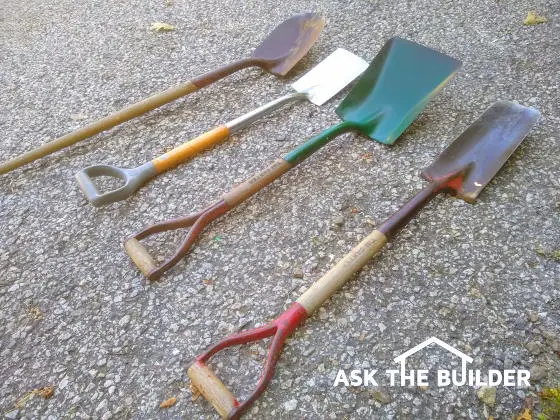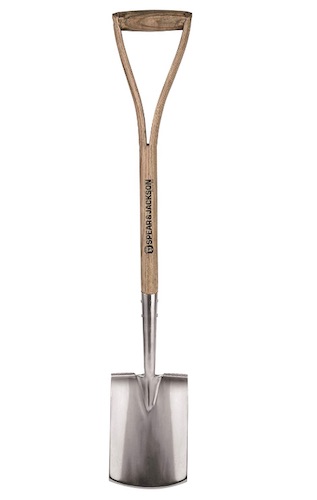
Shovel Choices 101 | This is an assortment of a few of my time-tested shovels. Each one is used for a specific task. Copyright 2020 Tim Carter
Shovel Choices 101 - Which One To Use
QUESTION: Mr. Tim, this past week I wasted all sorts of time and got frustrated trying to dig a simple hole in my yard. A neighbor looked over the fence and suggested I change shovels. Anyway, I figured you’ve used lots of shovels in your career and might help me start a decent collection so I won’t be frustrated ever again. Tell me all about the shovels I’d see if I came over to your house or stopped by one of your job sites. How do you store them? Barry K., Tulsa, OK
My guess is you might have been in the same situation as Barry at some point. It’s not that uncommon as I’d venture to say most people only have one or two shovels in their garages or sheds. Me, I’ve got about ten different ones with a few duplicates.
Just two weeks ago, I went on an adventure with my youngest daughter. She’s a potter and discovered I had a conversation a year ago with a local historian I met on a hike to a stunning overlook here in central New Hampshire, The Ledges. I found out that an early homesteader who’s old house foundation was on the hike had become a wealthy businessman. He discovered a large and deep continental glacial clay deposit and mined the clay making countless bricks for all the locals to use to build their fireplaces and chimneys.
Why did you bring that odd-looking shovel?
While hiking from my truck through the woods to the clay deposit my daughter said, “Dad, why did you bring that odd-looking shovel?” I had in my hand a duckbill shovel. It’s a long narrow shovel with a small cutting tip. It allows me to dig fast because there’s less resistance. I also knew I was only interested in getting about three-quarters of a cubic foot of clay to test it to see if it’s great for a few small pottery items.
It turns out it was the perfect shovel to use for this project because there was a small exposed vertical cut of the clay where I could scrape and cut a horizontal hole harvesting clay that had not seen the light of day for 15,000 years. Yes, my degree was in geology!
What type of shovel should be used?
The type of shovel you’ll use for a project depends on both the material you’ll be shoveling, whether it’s densely packed, loose, or even the shape of the hole you’re creating. For example, imagine the task that telegraph pole installers faced 170 years ago. They had to dig 12-inch diameter holes straight down about 5-feet deep! Think of how specialized those shovels had to be to create that perfect shaft! You can still see them if you’re able to watch a modern utility crew set a new pole!
The Basic Shovel
Let’s start with the most basic shovel. I feel it’s the round-point shovel. They come with all sorts of handle options including a short one with a D-handle. The tip of this shovel resembles what you see in a deck of cards when you look at the simplistic shape of the spade symbol. The tip of the shovel allows you to slice into dirt, through small roots, etc. with ease. Everyone should have at least one round-point shovel.
The Square-point Shovel
The next shovel I’d have is a square-point shovel. The industry usually calls these transfer shovels. They have a shallow pan profile but the cutting edge is straight across and blunt. These are perfect for shoveling loose material like sand, small rounded gravel, and grain. I’ve worn out quite a few of these shovels from handling tons of rounded pea gravel! You’ll never regret having one of these shovels.
The Duckbill Shovel or Drain Spade
If you plan to do trenching, you’ll want a duckbill shovel. Once again, you may find one called a drain spade. These have a rounded tip that cuts into soil or clay, but the body of the shovel is almost 2x longer than a normal shovel. It’s also narrower so you encounter less friction when making a deep cut. I’ve created thousands of feet of 16-inch-deep trenches with these shovels. Be sure to get one with a D-handle for ease of use.
The Garden Spade
One of my favorite shovels is the garden spade. These have a very flat shape and a blunt edge. They are my tool of choice if digging in clay where I want to create a very square hole with smooth sides. You can shave moist clay with these shovels like you’d shave off wood using a sharp wood plane or chisel.
Get this amazing stainless-steel one!

I've owned this stainless steel spade for almost 20 years. It looks PERFECT. NO RUST! CLICK or TAP HERE or the photo to have it delivered to your home.
Digging with a Pressure Washer
While it’s not a shovel, one innovative thing you can use to dig in certain situations is a pressure washer. You MUST wear goggles when doing this, but believe me, a pressure washer can cut through dense clay soil quite quickly. It’s a fantastic option to use should you need to tunnel under a sidewalk.
Using PVC Pipe as a Digger
Another method to tunnel is to use a piece of PVC pipe that you cut off an end at a 45-degree angle. You tap this cut end into the soil, twist it, and then pull it backwards removing the plug of soil inside the pipe. I recorded a video showing this method and you can watch it on my AsktheBuilder.com website. Type “tunnel” in the search engine on my website and the video will pop right up.
How to Clean Your Shovel after Each Use
If you want your shovels to dig with ease each time you use them, you must clean and oil them after each use. Hardened clay on a shovel creates more resistance when digging. If you have an old 5-gallon bucket, fill it with sand and pour some used motor oil into the sand until the sand is well saturated. Push the shovel into the sand and it will get coated in seconds with oil that will prevent rust.
Column 1367
The post Shovel Choices 101 appeared first on Ask the Builder.
No comments:
Post a Comment